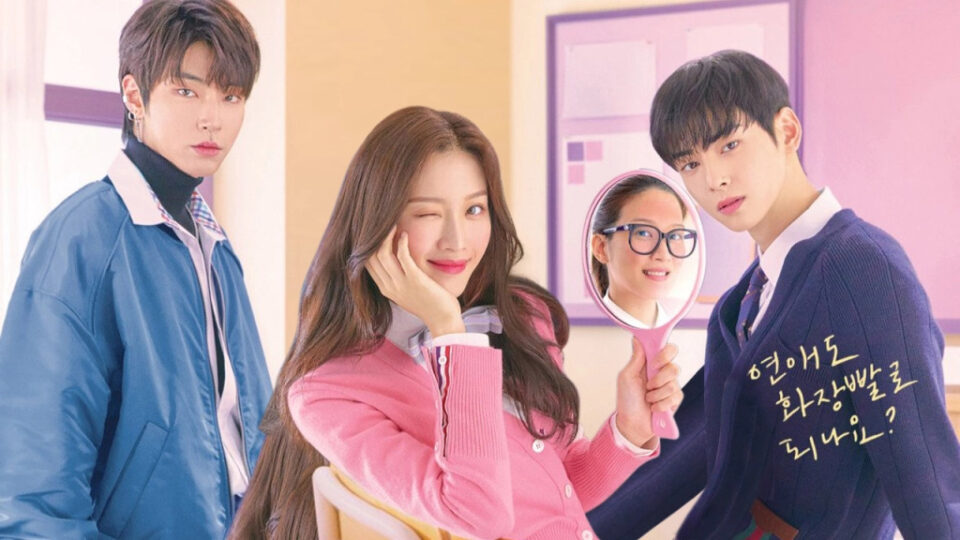The Significance of K-Drama Tropes
The logic underpinning how we enjoy K-drama tropes stems from both the ease of routine and the thrill of novelty. They stay at the forefront of what makes K-dramas so engaging as a storytelling form

Popular K-drama tropes, such as a 'love triangle,' create a relatable scene by playing on common emotions. We become used to and feel connected when such storylines and character arcs are reproduced. The featured poster image of the hit rom-com K-drama 'True Beauty' is an excellent illustration of a love triangle, starring (from left to right) Hwang In-youp, Mun Ka-young, and Cha Eun-woo. Photo courtesy of tvN
Something that makes me happier to watch K-dramas is the sense of belonging that we all share through our fondness for them. That said, I often run into others who fault K-dramas for relying on tropes. I’d say creators deliberately choose to use tropes. You see, employing them—recurrent themes, plot devices, and character archetypes—in K-dramas is a big selling point; they are essential to the way we like them.
Tropes are similar to information agents in that they facilitate a quick understanding of a narrative while also forging an emotional connection with it. If you look at how tropes came to be, there’s a rich history deeply ingrained in literary tropes. From the famous Greek mythological figures to the stock characters of Commedia dell’Arte, tropes have played a role in creating captivating stories.
A few popular tropes—”overbearing CEO,” “haters to lovers,” “the Cinderella trope,” “love triangle,” “friends to lovers,” and “contract marriage,”—are often the nuclei of K-dramas. Used to keep us engaged, these elements and plot points have become genre mainstays. In fact, K-dramas give us a sense of comfort by using these cliches to induce predictability, which gives us a sense of comfort.
The make of a K-drama is such that it lays like a framework directing the narrative flow through familiar tropes. Because of this framework, we can seamlessly follow along with the story and connect with the characters. Besides, tropes are cultural currencies, reflecting social conventions, values, and beliefs.
Recursive tropes, in my opinion, enable stories to address present-day issues, dispel myths, and offer nuanced viewpoints on difficult subjects.
K-drama tropes are prevalent in multiple themes and genres. Whether it’s a heartwarming romance or a thrilling mystery, there are common tropes in each. Some of these in K-dramas include the “love triangle,” where the protagonist must choose between two lovers, and the “childhood connection,” in which characters who knew each other as children reunite as adults.
Another popular K-drama trope is the “rich guy is smitten with the poor girl,” where characters from various socioeconomic origins overcome the hardships of their disparate environments while finding common ground in their relationships. The trope frequently delves into themes of class discrepancy, personal growth, and the power of love to overcome societal obstacles.
K-drama tropes have evolved over the years. While some tropes—such as “haters to lovers”—have endured over time, others—such as “friends to lovers”—are changing to reflect our changing tastes. This variation prevents the genre from becoming dull or stale and keeps it entertaining. A good example of this could be the coming-of-age drama Twenty-Five Twenty-One (2022), which did in part follow the trope but did not end in a predictable way, which was a surprise. But we did love it, didn’t we?
So, this willingness to adapt and reinvent classic tropes ensures that K-dramas remain a dynamic and engaging form of entertainment for us.
The basic elements of human perception and emotion provide the psychology behind our love of tropes. We tend to look for patterns and draw connections, as I learned when I dug more into the psychology of tropes. Using their recurrent themes and character archetypes, tropes leverage this intrinsic cognitive mechanism, furnishing narrative structure and predictability. This cognitive ease makes it simple for us to comprehend the plot and enjoy seeing patterns that we are accustomed to.
The comfort that comes with familiarity is one of the main reasons that tropes are important. You may be critical of them and the character arcs they present, but you can’t deny that we grow used to and feel connected to them. While we are aware of the inevitable outcomes of trope-filled K-dramas, we still enjoy them to see the delightfully predictable events play out. The familiar plot devices serve to shield us from the complexity of unpredictable, multilayered stories.
And it’s not just about feeling connected. It’s also about healing. Popular tropes bring back memories and feelings connected to stories that are comparable to our own. This emotional resonance makes us far more immersed in them triggering a deep sense of empathy and feeling one with what we are watching.
It’s interesting how these dramas reinterpret and twist established tropes for thrills and newness. K-drama tropes’ play of surprise and things we’re sure of show the complexity of human emotions. As in real life, tropes provide a harmony between the expected and the unexpected, and we remain inquisitive as to how that will come along in each new drama.
K-drama tropes are quite significant in sharing Korea’s diverse cultural heritage. They represent the country’s habits, customs, and realities. So, by infusing tropes into their stories, K-dramas act like vehicles for cross-cultural exchange with their cohesiveness, relatability, and emotional engagement.
The logic underpinning our appreciation of K-drama tropes thus stems from both the ease of routine and the thrill of novelty. And once again, I repeat, tropes are useful for reasons beyond entertainment, as they stay at the forefront of what makes K-dramas so popular as a storytelling form.







